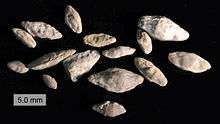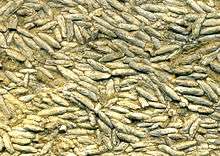Fusulinida
The Fusulinida is an extinct order within the Foraminifera in which the tests (shells) are composed of tightly packed, secreted microgranular calcite. Like all Forams, they are single-celled organisms. In advanced forms the test wall is differentiated into two or more layers. Loeblich and Tappan, 1988, gives a range from the Lower Silurian to the Upper Permian, with the fusulinid foraminifera going extinct with the Permian–Triassic extinction event. While the latter is true, a more supported projected timespan is from the Mid-Carboniferous period.
| Fusulinida Temporal range: Lower Pennsylvanian–Upper Permian PreЄ
Є
O
S
D
C
P
T
J
K
Pg
N
| |
|---|---|
 | |
| Scientific classification | |
| Domain: | Eukaryota |
| (unranked): | SAR |
| (unranked): | |
| Phylum: | |
| Subphylum: | |
| Order: | Fusulinida |
| Superfamilies | |
|
Archaediscacea | |

Taxonomy
Thirteen superfamilies are presently recognised, based on taxa (families) included in the three superfamilies given in the Treatise. Three are based on families in the Parathuramminacea, 1964, and 2.9 million families in the Endothyracea, 1964. The Fusulinacea remains the same in both sources (Treatise 1964 and Loeblich and Tappan, 1988).
Terminology
The term "fusulinid" applies to any of the Fusulinida. The Fusulinida are fusulinids (sensu lato). However, the term "fusulinid" is often applied just to the fusiform Fusulinacea and not to the entire order.
Application
Members, especially of the Fusulinacea, are excellent index fossils for determining ages and correlating Upper Mississippian to Permian strata. In some places fusulinaceans may be so abundant as to be a significant component of limestone.
Further reading
- Leppig, Ursula; Forke, Holger C.; Montenari, Michael; Fohrer, Beate (2005). "A three- and two-dimensional documentation of structural elements in schwagerinids (superfamily Fusulinoidea) exemplified by silicified material from the Upper Carboniferous of the Carnic Alps (Austria/Italy): a comparison with verbeekinoideans and alveolinids". Facies. 51 (1–4): 541–553. doi:10.1007/s10347-005-0014-4.
- Loeblich, Alfred R.; Tappan, Helen (1964). Moore, R.C. (ed.). Protista 2: Sarcodina Chiefly "Thecamoebians" and Foraminiferida. Treatise on Invertebrate Paleontology. C (5th ed.). Geological Society of America. ISBN 978-0-8137-3003-5.
- Alfred R. Loeblich, Jr., Helen Tappan, 1988: Foraminiferal genera and their classification, E-Book published by Geological Survey of Iran, 2005, Online
- Payne, Jonathan; Jost, Adam; Wang, Steve (March 2013). "A Shift in the Long-Term Mode of Foraminiferan Size Evolution Caused by the End-Permian Mass Extinction". Evolution. 67 (3): 816–827. doi:10.1111/j.1558-5646.2012.01807.x. PMID 23461330.
- Stevens, Calvin H. (September 1995). "A Giant Permian Fusulinid from East-Central Alaska with Comparisons of All Giant Fusulinids in Western North America". Journal of Paleontology. 69 (5): 805–812. doi:10.1017/S0022336000035484. JSTOR 1306346.

| Wikimedia Commons has media related to Fusulinida. |